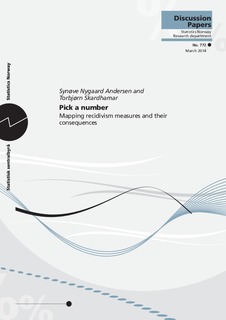Pick a number. Mapping recidivism measures and their consequences
| dc.contributor.author | Andersen, Synøve Nygaard | |
| dc.contributor.author | Skarðhamar, Torbjørn | |
| dc.coverage.spatial | Norway | nb_NO |
| dc.date.accessioned | 2019-11-12T07:56:41Z | |
| dc.date.available | 2019-11-12T07:56:41Z | |
| dc.date.issued | 2014-03 | |
| dc.identifier.issn | 1892-753X | |
| dc.identifier.uri | http://hdl.handle.net/11250/2627822 | |
| dc.description.abstract | Recidivism studies differ with respect to samples, definitions and follow-up periods. While it is recognized that such differences hamper comparability, there is little systematic knowledge about how recidivism figures are affected. We explore how deliberate changes in the following three parameters affect the reported recidivism levels: 1) sample definition, 2) measure of recidivism, and 3) length of follow up. We use administrative records from Norway which allow using total offender populations and combining information from several sources. Our results show that the proportion of reoffenders varies from 9 to 53 percent, depending on how, among whom and for how long recidivism is measured. | nb_NO |
| dc.language.iso | eng | nb_NO |
| dc.publisher | Statistisk sentralbyrå | nb_NO |
| dc.relation.ispartofseries | Discussion papers;772 | |
| dc.subject | Kriminalitet | nb_NO |
| dc.subject | Tilbakefall | nb_NO |
| dc.title | Pick a number. Mapping recidivism measures and their consequences | nb_NO |
| dc.type | Working paper | nb_NO |
| dc.description.version | publishedVersion | nb_NO |
| dc.subject.nsi | VDP::Matematikk og Naturvitenskap: 400::Matematikk: 410::Statistikk: 412 | nb_NO |
| dc.source.pagenumber | 29 | nb_NO |
Tilhørende fil(er)
Denne innførselen finnes i følgende samling(er)
-
Discussion Papers [1003]
